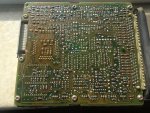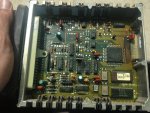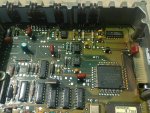yo JAMES,
WELCOME!
CM KOER
- 33 EGR valve not opening
DTC 33 is triggered when the EVP sensor is not closing;
Testing & Operation; "...The EGR Valve Position (EVP) sensor monitors the position of the EGR valve pintle. The EVP sensor converts the mechanical movement of the pintle into an electrical voltage signal which is relayed to the PCM. The EVP sensor is a linear potentiometer in which resistance varies with the EGR valve pintle movement.
Voltage is fed to the EVP by the signal return circuit. As the EGR is opened the EVP directs more voltage to the EEC and less down the voltage reference circuit. The EVP sensor provides the PCM with information on EGR flow and EGR system failures. The EVP should read between 0.24 and 0.67 volts at idle with a closed EGR valve..." read more
Source: by Ryan M (Fireguy50) at
http://web.archive.org/web/20130912124008/http://www.oldfuelinjection.com/?p=35
excerpts;
Damaged EVP sensor
•Corroded or dirty connector
•Damaged EGR valve
•Faulty Vacuum system
•Broken wire in harness
•Grounded harness
•Damaged Computer
I know you did the vac leak test, but pull vac hose off @ EVP - I pull em off and use the straw sucking test; one finger over one end; and... ya get the idea?
Testing & Operation; "...The EGR Valve Position (EVP) sensor monitors the position of the EGR valve pintle. The EVP sensor converts the mechanical movement of the pintle into an electrical voltage signal which is relayed to the PCM. The EVP sensor is a linear potentiometer in which resistance varies with the EGR valve pintle movement.Voltage is fed to the EVP by the signal return circuit. As the EGR is opened the EVP directs more voltage to the EEC and less down the voltage reference circuit. The EVP sensor provides the PCM with information on EGR flow and EGR system failures. The EVP should read between 0.24 and 0.67 volts at idle with a closed EGR valve..."
read more Source: by Ryan M (Fireguy50) at
http://oldfuelinjection.com/?p=35
EVP is light gray & attached to the top of the EGR Valve
EVP PIC by Waltman
 CM KOER
CM KOER
DTC 44 Thermactor Air Injection system inoperative (Right side).
DTC 44 (KOER); Right Thermactor Inoperative; "...I had a similar issue that turned out to be the vacuum line to the Thermactor Air Bypass Valve. No CEL, just a code; 1. First check that the two vacuum lines are connected to the Vacuum Reservoir (coffee can) and the resevoir is in good repair with no leaks on the bottom. Frequently the can leaks or the vacuum lines are accidentally knocked off. Check the vacuum hose to the bottom of the Bypass Valve. Check the vacuum hose to the Diverter Valve. Check the vacuum hoses to the TAB/TAD Solenoids. Then check your TAB/TAD Solenoids. These are common easy to miss problems. Once these are ruled out all that is left is: Thermactor Air Supply Hoses. One-way Check Valves. Main TAB/TAD Valves..."
Source: by Seattle FSB (SeattleFSB) at
http://fullsizebronco.com/forum/showthread.php?t=168505
DTC 44 (KOER) - Right Thermactor Inoperative - The thermactor system injects air into the exhaust ports in the heads downstream from the valves. Air is supplied from the smog pump through tubing and the TAD/TAB valves to a copper pipe between the heads on the firewall side of the engine, and ultimately to the exhaust passages. If your smog pump is disabled, or your disconnected the tubing or blocked the thermactor holes in the back of the heads, or if the TAD/TAB valves are bad, you will get these codes. My car has all of this stuff removed and used TFS Track Heat heads (with no thermactor provision), and naturally pulls these codes.
Source: by Matthew
DTC 44 (KOER); Right Thermactor Inoperative; "...indicates a Thermactor Air System leak which could be anywhere from the smog pump up front to include EGR solenoiids over on the right inside fender liner and all the way to the back of the engine which is what you see in the photos. There is also a smog tube that runs along the passenger side engine below the valve cover which runs to the back of the FI plenum up to a Air Bypass Valve (plastic) crossing over to the cross-over tube (exhaust) which is connected to that and the CAT, check valve and tube below. the Thermactor system is designed to capture spent gases and ultimatley send them down to the CAT to burn off etc.If you look closely you'll see the chek valve and CO tube is pipe threaded, use some anti-seize and don't over tighten and when putting the valve on the tube, you don't need a gasket for the CO tube ends but rather just use some bearing grease which melts and forms a nice gasket seal.....this is a tip from Steve83; gaskets burn off and go away after a while and you're back with another vacuum leak etc..."
Source: by JKossarides ("The Bronco", Jean) at
http://fullsizebronco.com/forum/showthread.php?t=150013
DTC 44 Problems in the Thermactor Air Control system. Check vacuum lines, air pump, diverter valve, and solenoids.
Source: by miesk5






